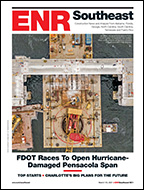Welding on piers of the new San Francisco-Oakland Bay Bridge are set to resume once workers finish filling in the gaps left by an extricated 6-ft weld sample that the Federal Highway Administration declared free of defects May 4.
Welders last week were cutting out three 5.5-ft vertical shear plates in one bridge footing that are connected by partial joint penetration welds to bridge piles. They then reweld, patching holes left by the extricated welds with new metal, and install new shear plates. Dan McElhinney, California Dept. of Transportation Toll Bridge Engineering Manager, says when that is complete, welding will resume on the remaining four of 28 footings.
It is possible that the 2.5 weeks of lost time on the $6.2-billion project can be made up, McElhinney says. He would not directly comment on costs. "Typically the delay with this much heavy equipment on site is between $208,000 and $400,000 per day," he says. The Kiewit Pacific Co.-led KFM joint venture contractor has continued work on skyway segments for 24 of 28 footings already completed.
Fifteen former KFM employees had told the Federal Bureau of Investigation that defective welds were deliberately left in place (ENR 4/18 p.14). But independent field and destructive tests "showed excellent workmanship," says an FHWA report, after Seattle-based Mayes Testing Engineers tested the sample welds in its lab.
Sandra Benson, an attorney for Pildedrivers Local 134, says, "The union always knew the welds were good" and says relations are good between the contractor and its workers. "I understand the FBI is looking into whether false claims were made, but the claims do not impact the standing [of the welders who made the accusations] as union members."
The May 4 report came the day after a state Senate committee approved a $7.7-billion bond measure for the November 2006 ballot to fund completion of the controversial bridge. McElhinney hopes bidding could begin in August if a decision is made soon on whether to stay with the self-anchored suspension segment during this legislative session. The innovative design has been criticized by lawmakers because of high costs.

